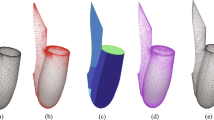Abstract
Performing a finite element analysis requires overlaying an object with a mesh of varying density based on the expected stress levels within the part. Attempts have been made in the past to automat the finite element meshing procedure. The method presented here is “intelligent” in the sense that it examines the complete part for potential stress gradients and decomposes the part into hexahedral regions according to the geometry gradients in the part. High geometry gradients are regions of high curvature, especially edges. The algorithm segregates high gradient features into isolation volumes. It then continues to decompose each isolation volume dependent on the particular geometry contained in the feature. The result is a set of hexahedral bricks suitable for passing to an automatic meshing routine.
Similar content being viewed by others
Explore related subjects
Discover the latest articles, news and stories from top researchers in related subjects.References
Ansaldi S, DeFloriani L, Falcidieno B (1986) Form feature Representation in a structured boundary model. In: Cantoni V, Levialdi S, Musso G (eds) Image-Analysis and Processing. Plenum, New York, 1986, pp 111–120
Chavez PF, Henderson MR, Razdan A (1988) Automatic 3-D finite element modeling using solid model data and AI techniques. Proc ASME International Computers in Engineering Conference and Exhibition, San Francisco, CA (August 1988)
Dong X, Wozny M (1988) Feature extraction for computer aided process planning. Proc 3rd Int Conf Computer-Aided Production Engineering, Univ Michigan, Ann Arbor, MI (June 1988)
Henderson MR, Anderson DC (1984) Computer recognition and extraction of form features: a CAD/CAM link. Computers in Industry 5:329–339
Henderson MR, Chang GJ (1988) A knowledge based feature recognition and process planning system. Proc ASME International Computers in Engineering Conference and Exhibition, San Francisco, CA (August 1988)
Henderson MR, Razdan A (1988) Feature-based neighborhood isolation techniques for automated finite element meshing. In: Geometric Modeling for Product Engineering (October 1989) North-Holland Publishing
Joshi S, Chang TC (1988) Graph-based heuristics for recognition of machined features from a 3D solid model. Computer Aided Design 20(2)
Kela A, Perucchio R (1986) Toward automatic finite element analysis. Computers in Mechanical Engineering (July 1986), pp 57–72
Kyprianou LK (1980) Shape classification in computer aided design. PhD Thesis, Cambridge Univ (July 1980)
Mantyla M (1988) An introduction to solid modeling. Computer Science Press, Rockville, MD
Musti S, Henderson MR (1988) Automatic group technology part classification and coding from a solid model database. Trans ASME, Journal of Engineering for Industry, (August 1988)
Razdan A (1988) Feature based object decomposition for finite element mesh generation. MS Thesis, Arizona State University, Tempe, AZ (October 1988)
Shephard MS (1989) Approaches to the automatic generation and control of finite element meshes. Applied Mechanics Review
Author information
Authors and Affiliations
Rights and permissions
About this article
Cite this article
Razdan, A., Henderson, M.R., Chavez, P.F. et al. Feature based object decomposition for finite element meshing. The Visual Computer 5, 291–303 (1989). https://doi.org/10.1007/BF01914787
Issue Date:
DOI: https://doi.org/10.1007/BF01914787




